Freediving and underwater photography are a match made in heaven, so it was inevitable that we would write an article about it. In fact, we had so much fantastic information from underwater photographers that we decided to turn the spotlight on them for a change, and learn about their experiences from behind the lens.
Continuing the Underwater Photography series we speak with scuba diver, photographer and one half of MarinePix, Rob White to find out what led him to underwater photography and what advice he would give to any aspiring photographers.
Emma: So, Rob, firstly so great to catch up again! Tell us what your background is in photography, and what led you to specialise in underwater photography?
Rob: I used a compact film camera when I was growing up but I never considered underwater photography. I found the process a little slow and unrewarding, despite taking some nice pictures every now and then.
In 1997, I learned to scuba dive and for many years, I was satisfied with diving simply for the thrill of it but I always struggled to convey just what amazing things there are to see to my non-diving friends. A short time after digital cameras became popular and relatively cheap, and with a little encouragement from friends, I decided I would get a camera, housing and strobe light to take with me on a trip to the Philippines – I think the positive feedback I got on that trip spurred me on and encouraged me. Later, I was to meet Alex Mustard, a world renowned underwater photographer and the pictures he showed me encouraged me to move from a compact to a digital SLR camera. From taking my first photos underwater, I now find pleasure in all sorts of photography, not just underwater and I’ve a very varied collection of images in my portfolio.
Emma: Fantastic! I know you have started to freedive, so what are your freediving qualifications?
Rob: I’m not a qualified freediver yet but I think it’s inevitable… I just need to leave the camera behind long enough to do the training!
Emma: I can work on that! And Scuba diving? I know you Scuba dive too. What are your scuba diving qualifications?
Rob: Yes I do! I’m a PADI Master Scuba Diver Trainer… that’s a posh way of saying I’m a qualified SCUBA instructor.
Emma: Moving on to equipment, describe your camera set-up, where you got everything from and how it is configured?
Rob: The camera I’m currently using in a D800 in a Nauticam housing. I use 2 Inon strobes attached to the housing and every now and then, I’ll take extra strobes with me on a dive so I can be more creative, lighting up things at a distance or perhaps lighting the inside of a wreck.
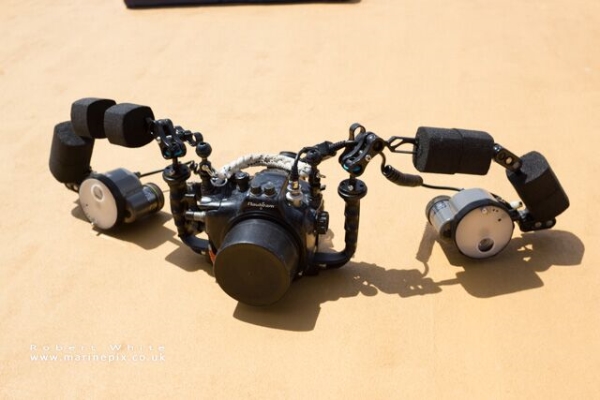
Initially though, I used a Canon G6 compact camera in an Ikelite housing and before moving to a Canon 550D in a Nauticam Housing. I’m a big fan of Nauticam.. if I ever have any issues (which are rare) I can get almost instant support from the team in the UK.
Emma:What post-production software do you use?
Rob: Although I try to get my photos right with the camera, it’s inevitable that they need some tweaking back on the computer. Unless you light a subject underwater, it is likely the photo will appear to be shades of blue but you can still drag colours from even the bluest of photos if necessary. The one stipulation for being able to do this is to take photos in RAW (the camera’s native image capture format where all the information the camera gathers is stored) rather than JPG (where information not used in creating the one image is discarded).
Emma: Do you have any tips for processing underwater photography?
Rob: Whilst each image requires different work, I find I’m often doing the same things to lots of images:
Crop the image. It’s fairly normal for me to crop an image to remove distractions from the background or perhaps to put the subject at a better position in the picture.

Colours. If I’ve not used a flash for a photo, I’ll usually find I push my colour temperature towards the yellows and my tint sliders toward magenta. I’ll also increase vibrancy and reduce saturation. This often helps exaggerate the subtle colour differences in an image that’s initially just shades of blue.
Fix the exposure. Ambient light is lower under water so what looks good on the back of the camera is often misleading in terms of exposure so the first thing I’ll do with a photo is ensure it is bright enough to show off the subject properly.
Increase the contrast. RAW files appear quite muted in tones so increasing the contrast can give them a little more impact.
Darken the highlights. Any areas of the image which are very very bright will distract the eye of the person looking at your photo so it’s worth reducing the “glare” from that brightness by reducing the highlights.
Lighten the shadows. In the same way that light areas will distract, so too will very dark areas. It’s likely there is some interesting information to be found in those dark areas which your eyes could see but the camera couldn’t distinguish. Lightening the shadows helps this.
Darken the blacks. this is a very subtle change which achieves a similar thing to boosting the contrast of an image. Too much and you create a fake looking image.
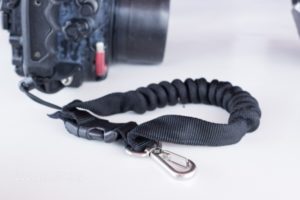 Emma: Lots of great tips there! So, what is the one piece of equipment you couldn’t be without?
Emma: Lots of great tips there! So, what is the one piece of equipment you couldn’t be without?
Rob: My camera, of course! My camera and I are always joined by a lanyard of some sort – that means I can use my hands for other things should an emergency arise and I don’t need to risk losing the camera.
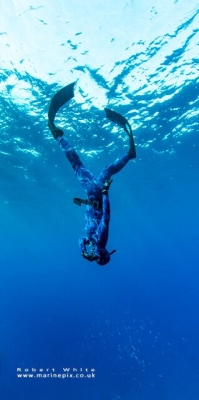 Emma: Do you use an assistant/buddy/model when you take photos? If so, who is your favourite one and how do they help you get your shots?
Emma: Do you use an assistant/buddy/model when you take photos? If so, who is your favourite one and how do they help you get your shots?
Rob: I do! There are good reasons to have a person in your photo.. it makes a photo more engaging; it makes it easier for the viewer to imagine themselves in the place of the person, or the photographer, it can also make the environment seem more inviting but photographically, it often helps balance out a picture, rather than having a great expanse of blue around your subject.
It tends to be other divers who understand this concept that make the best models as they have an instinct for where to put themselves and what position to be in. My partner, Pash is an amazing photographer but she’ll willingly put her camera to one side and model for me. Luckily for me, she’s an expert who will go to great lengths to help me create the image I’m after… she’s got great buoyancy and that results in a very calm appearance with hoses, legs and arms all tucked in and streamlined. divers with arms and legs spread out look rather ungainly and loose hoses tend to imply careless divers which is definitely not the sort of image I want to portray.
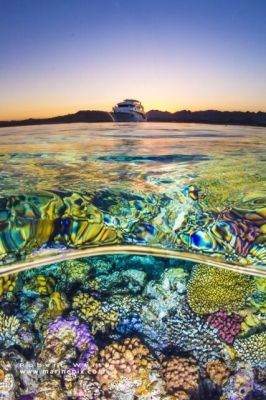 Emma: She is amazing! Moving on to photos now. Where have you taken photos underwater?
Emma: She is amazing! Moving on to photos now. Where have you taken photos underwater?
Rob: I’ve been to many places for diving, in fact it’s rare I go on non-diving holiday at all these days!
Whilst the UK is a great place for diving, having everything from sharks and seals to nudibranchs and lumpsuckers, the weather and water temperature limit the times you can spend comfortably underwater. As such, it’s nice to go abroad when finances allow. The Red Sea is certainly world-class when it comes to diving locations and the infrastructure is so well established that a holiday here is really straightforward.
You can see a huge variety of creatures in the Red Sea but for some reason the far east is a hot-spot for underwater life. Especially tiny, “macro” life. I’ve been to the Philippines and Indonesia numerous times and each trip I’ll see something amazing that I’ve not seen before. It’s these creatures that I love to photograph.Some animals are so rare and shy that it feels a real privilege to be able to photograph them but I always give priority to the animal’s welfare – I see no point is causing stress to an animal just so I can selfishly have a picture of it on my computer.
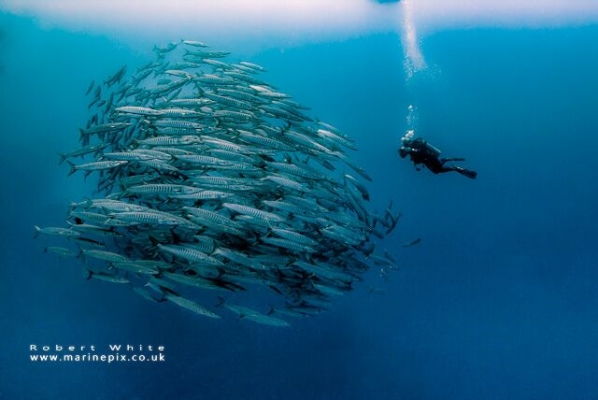
I had a huge amount of fun on a trip to the Red Sea and we concentrated solely on photographing schools of fish at Ras Mohammed. Diving with a big school of fish is, without doubt, one of the most amazing experiences you can have and the schools of Snapper, Bat fish, Unicorn Fish and Barracuda that gather at Ras Mohammed every year are a huge favourite of mine… They’re also one of the hardest things I’ve tried to photograph too. The school will effortlessly drift away as you swim towards it meaning you can swim for several minutes thinking you’re not getting any closer while in fact you’re a long way from the reef and into blue water.
Emma: That’s very true! What about competitions? Have you ever entered any?
Rob: One of the first competitions I entered, was the Lundy Island Splash-In. Lundy Island is a Marine Protected Zone in the Bristol Channel which is home to a colony of grey seals. My photo of a seal sitting in the kelp with sun rays shining down placed 3rd and I won a fantastic set of dive thermals. I’ve entered several competitions over the years and have won all sort from a waterproof camera to a full-blown Red-Sea holiday so I’ve been rather fortunate.
Emma: Congratulations! So what is the best piece of advice you can give to someone starting underwater photography?
Rob: Be prepared to start an addictive hobby!
Seek out someone to give you honest feedback and try to emulate other photos that you have seen that you like.
It’s a good idea, once you’ve got an idea of how to control your camera, to join an underwater photography workshop. It doesnt need to be one to one – it’s possible to learn from the other people on the course too.
Emma: OK! What kit do you think every beginner should start with?
Rob: Light is all important in photography and arguably more so when you’re underwater so I think it’s very worthwhile having a portable light. While a torch is a good start, it wont afford you the flexibility that you’ll get from a proper underwater flash-gun.
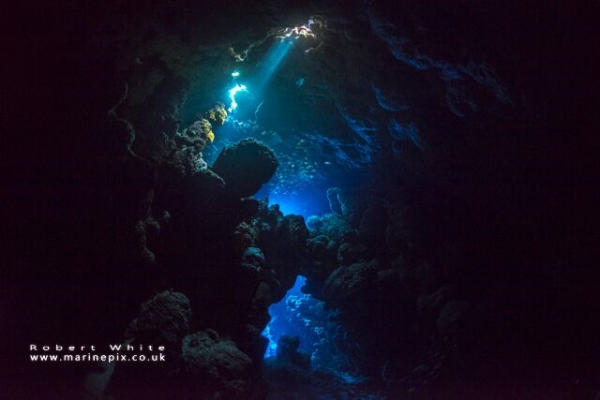
Emma: Are there books on online resources you believe would benefit anyone starting underwater photography?
Rob: Definitely, there’s one book that I think every photographer should read at some point although it’s not about underwater photography specifically. It’s Light, Science and Magic. Now in it’s 5th edition.
If it’s underwater photography in general, there’s a huge amount of information in Martin Edge’s book – “The Underwater Photographer“
If you want something a little more travel-friendly, Alex Mustard’s book “Underwater Photography Masterclass“
If you want some inspiration, it’s well worth looking through the entries of the Underwater Photographer of the Year (UPY) competition. There is some amazing stuff that appears there each year.
Emma: Which is the best underwater photography blog out there right now?
Rob: I don’t think I’ve encountered any underwater photography blogs as such. Perhaps, like my own, they’re not particularly well marketed. In preference to reading about stuff, all I need is to see an image I like to give me the desire and inspiration to get out there and do something! It’s usually Alex Mustard’s photos that I find most inspiring and Alex is very good at keeping his Facebook page updated.
Emma: They are amazing! What are YOUR top five tips for taking photos underwater?
Rob: Know your subject – if you know how your subject behaves, you can anticipate what it will do. For instance, some fish will stay still and try to rely on their camouflage to protect them, others will swim away if they get spooked so making a slow, calm approach is much more important.
Know your camera – if you don’t know where to find controls, you’ll end up wasting time and often not getting enjoyment from the dive nor the photos afterwards.
Plan and practice your shot before approaching your subject – work out how you want to light your shot and move your lights into position. Make a best guess at how much power you’ll need and the appropriate camera settings. If you have opportunity, practice on a similar sized subject which won’t get spooked (eg a rock)
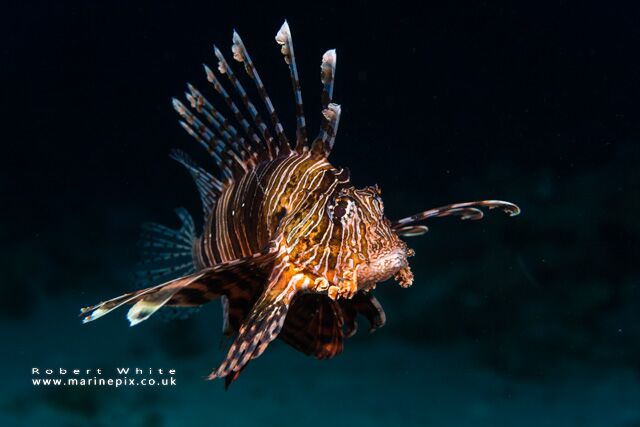
Get your buoyancy right – it’s essential for a number of reasons but generally, taking a photo takes concentration so you have to be confident you’re not sinking or floating up while you look at the back of the camera. You still need to be a safe diver while you’re photographing
Don’t take the photo if you’re going to damage the environment or stress the animal. (stressed animals can sometimes bite or sting in defence but in some cases they can even die as a result of the stress)
Emma: Excellent advice! What is the most common mistake you see from beginner/novice/amateur underwater photographers?
Rob: I think the main difference between those people starting out and those that produce high-quality images is the amount of time taken with a subject… Very often, beginners don’t take enough time with a subject.. they’ll take one photo and check it on the back of the camera, maybe take another photo after some basic adjustments but then they’ll leave. It’s likely someone more experienced will take extra time and care over a shot, making sure that the background is as clear as possible, that the creature is making eye-contact with the camera, that the lights are not reflecting off particles in the water, etc, etc. They’ll correct all these things until they finally have a photo they’re pleased with and then they’ll move off.
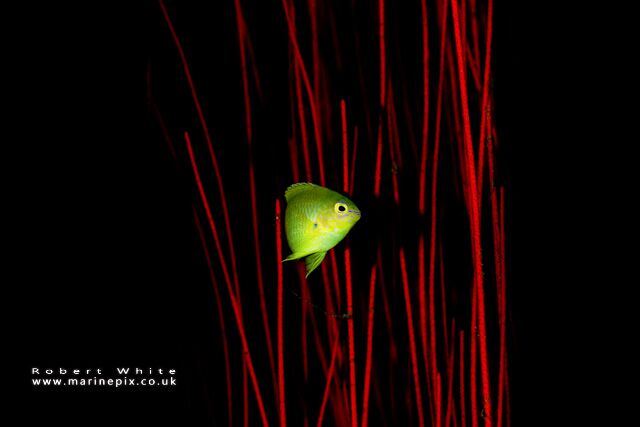
Emma: That makes total sense. So, what is your next project?
Rob: I’ve seen some exciting photos from what are termed “Black Water dives”. These are essentially night dives in mid-water. Critters that are attracted to the photographers lights are often juvenile or larval forms of the fish you might see on the reef during the day. The contrast between these interesting animals and the black background is something I’m really looking forward to having a proper go at.
Emma: Looking forward to seeing them! Talking of which, where can people find you/buy your work?
Rob: Pash and I put photos up on our facebook page (www.marinepix.co.uk/marinepix) but we also upload to the website (www.marinepix.co.uk) . The idea is that people can order prints of whatever photos have been uploaded just by getting in touch. We think it’s important to print images with the same respect and care that goes into taking them. We see little point in using a high-street printing service which delivers inconsistent and often sub-standard colour rendition so we use professional printing labs for all our prints. The images we have around the house tend to be printed onto acryllic or directly onto aluminium which requires quite a lot of preparation and colour management but ultimately results in a striking piece of contemporary looking wall art. Since we sell so few images – people would rather get their own images printed, we offer workshops and courses in a pool local to us in Sussex.
Learn to freedive with Go Freediving in 2018
Go Freediving is the longest established, most experienced and friendliest freediving course provider in the UK, led by world class freediving instructor trainer Emma Farrell, and her team of personally trained instructors. No other course provider has such a good instructor to student ratio, safety record and personal touch.
Whether you’re a beginner dipping your toes into the world of freediving, a seasoned pro looking to turn professional, or simply a freediver of any level who wants the best freediving holiday in the world, we’re here for you!
Also check out our online guide, The Beginners Guide to Freediving by clicking here!
Keep in touch with everything Freediving
Subscribe to our mailing list for weekly newsletters with exclusive articles, news, films, offers and more!

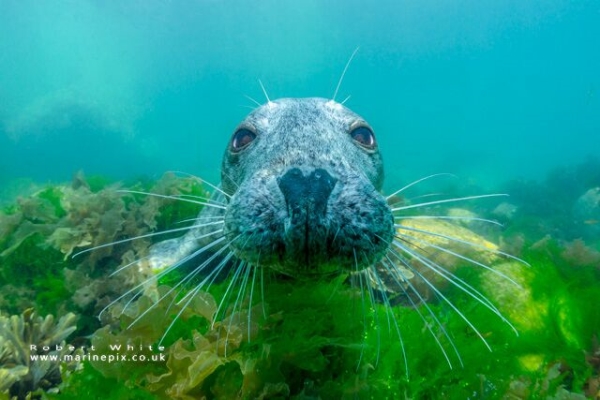

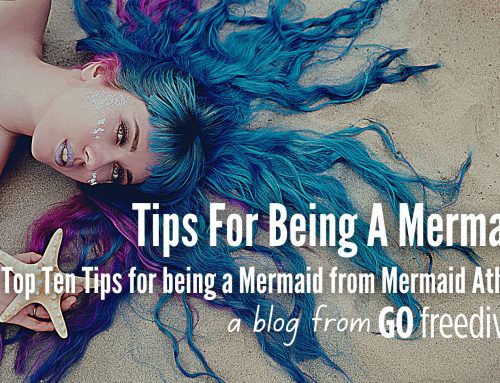

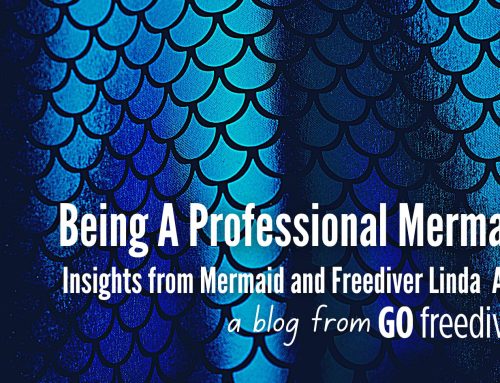
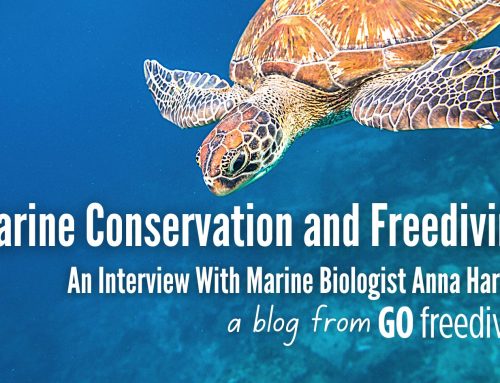
Leave A Comment